 W
WDonkey Kong is a series of video games published by Nintendo and created by game designer Shigeru Miyamoto in 1981. The series mainly consists of two genres: single-screen platform/action puzzle games featuring the gorilla Donkey Kong as the main antagonist, and side-scrolling platform games where Donkey Kong and his clan of other apes are the protagonists and player characters who usually battle the crocodilian villain King K. Rool. Additional spin-off titles of various genres have also been released.
 W
WBirdo, known in Japanese as Catherine , is a fictional character in the Mario franchise. Her first appearance was as an enemy in Yume Kōjō: Doki Doki Panic, which was localized for English-language audiences as Super Mario Bros. 2. Since then, Birdo has been a recurring character in various franchise spin-offs. Initially, she was depicted as an antagonist, but has since been depicted as an ally. Birdo has also made several cameos, particularly in the Mario Kart series and the Japan-only Wii video game Captain Rainbow.
 W
WBoos, known in Japan as Teresa, are fictional ghosts from the Mario and Yoshi series of video games. They first appeared as a common enemy in 1988's Super Mario Bros. 3, in which they were called Boo Diddleys. Since then, they have been a mainstay in the Mario series, usually appearing as enemies, but occasionally appearing as playable characters in the Mario spin-off games, or even as allies of Mario. They also have prominent roles in Luigi's Mansion, Luigi's Mansion: Dark Moon and Luigi's Mansion 3. They are named after the sound that one might make when trying to frighten someone ("boo!"), whereas their Japanese name comes from the verb 'tereru' (照れる), meaning 'to be shy'.
 W
WBowser , or King Koopa, is a fictional character and the primary antagonist of Nintendo's Mario franchise and is the archenemy of Mario. In Japan, the character bears the title of Daimaō . Bowser is the leader of the turtle-like Koopa race. Despite the fact that Bowser has teamed up with Mario in a few games, his ultimate goals are to kidnap Princess Peach, defeat Mario and Luigi to conquer the Mushroom Kingdom. Bowser's defining traits are his monstrous appearance with dragon-like elements, full-throated roar, fire-breathing abilities, cruel personality, bestial reptilian voice, never-ending conflict with Mario, and unrequited crush for Peach.
 W
WBowser Jr. is a fictional character who appears in Nintendo's Mario franchise as an antagonist. He is the son of the series' main antagonist, Bowser. Since his debut in Super Mario Sunshine in 2002, Bowser Jr. has been a recurring character in the Mario series and has been made playable in several spin-offs, such as Mario Superstar Baseball, Mario Strikers Charged, Super Smash Bros. for Nintendo 3DS and Wii U, and Super Smash Bros. Ultimate among many others. He often helps his father to kidnap Princess Peach and defeat Mario, but in the end wants nothing more than to impress his father. Bowser Jr.’s defining traits are his striking resemblance to his father, his energetic and driven personality, his expertise in mechanics and technology, his heavy uses of his Junior Clown Car and Magic Paintbrush.
 W
WThe Mario franchise is a collection of video game series by Nintendo. While Nintendo is usually their developer and publisher, various series are usually developed by other third-party companies, such as Hudson Soft and Intelligent Systems. The games primarily revolve around Mario, and usually involve the motif of Bowser kidnapping Princess Peach and Mario rescuing her. Various characters have different plots and goals that vary in each series; for example, the Luigi's Mansion series focuses on Luigi ridding his new mansion of ghosts, while Wario stars in games that center around his greed and desire for money and treasure.
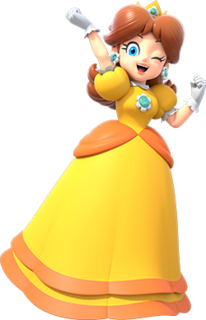 W
WPrincess Daisy is a fictional character in the Mario series of video games. She debuted in 1989's Super Mario Land as the ruler of Sarasaland. Described as a tomboy, she has been rumored to be Luigi's love interest, similarly to Princess Peach being the love interest of Mario. This became the plot of the 1993 live-action film Super Mario Bros., in which Luigi saves Daisy from King Koopa.
 W
WDiddy Kong is a fictional character who appears in games belonging to the Donkey Kong and Mario video game franchises, debuting in the 1994 Donkey Kong series game, Donkey Kong Country. Nintendo designer Kevin Bayliss commented Diddy Kong was "penciled in" as a spider monkey, although he is not specifically referenced as belonging to a particular species. He lives with Donkey Kong on Donkey Kong Island in the Kongo Jungle, and is identified by his red hat with the Nintendo logo, and his red shirt with stars.
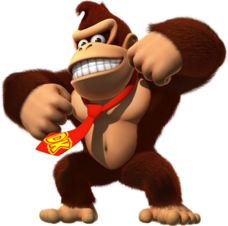 W
WDonkey Kong, also shortened to DK, is a fictional ape in the Donkey Kong and Mario video game series, created by Shigeru Miyamoto. The original Donkey Kong first appeared as the title character and antagonist of the eponymous 1981 game, a platformer by Nintendo, which would lead to the Donkey Kong series. The Donkey Kong Country subseries was launched in 1994 with a new Donkey Kong as the protagonist. This version of the character persists as the main one up to today. While the 1980s games' Donkey Kong and the modern Donkey Kong share the same name, the manual for Donkey Kong Country and subsequent games portray the former as Cranky Kong, the latter's grandfather, with the exception of Donkey Kong 64, in which Cranky is depicted as his father. Donkey Kong is considered one of the most popular and iconic characters in video game history.
 W
WFawful, known in Japan as Gerakobits , is a fictional character appearing in the Mario & Luigi series of role-playing video games developed by AlphaDream, serving as the secondary antagonist of Superstar Saga and the main antagonist of Bowser's Inside Story.
 W
WKing K. Rool is a fictional anthropomorphic crocodile and the main antagonist in Nintendo's Donkey Kong video game franchise, as well as the archnemesis of Donkey Kong and Diddy Kong. K. Rool is the villainous leader of a group of crocodilian raiders known as the Kremlings, who have crossed paths with the Kongs on many occasions. First appearing in the 1994 video game Donkey Kong Country for the Super Nintendo Entertainment System, he has been described as being "to Donkey Kong what Bowser is to Mario." He is depicted as unstable, adopting different personae and titles and utilizing a variety of weapons to his advantage. K. Rool resembles an overweight crocodile with an infected, bulging eye. The name "K. Rool" is a play on the word "cruel", a reference to his malevolent nature. He also appeared as a playable character in Super Smash Bros. series. In addition to video games, K. Rool has appeared in the manga adaption of Donkey Kong Country, the Donkey Kong Country animated series, comics and several pieces of Nintendo merchandise.
 W
WThe Koopalings are a fictional group of seven childlike characters in the Mario video game franchise by Nintendo. Their individual names are Larry Koopa, Morton Koopa Jr., Wendy O. Koopa, Iggy Koopa, Roy Koopa, Lemmy Koopa, and Ludwig von Koopa. Originally depicted as the children of the series antagonist Bowser, they first appeared in 1988 game Super Mario Bros. 3. They have since appeared in subsequent Super Mario games and spin-off Mario games.
 W
WLuigi is a fictional character featured in video games and related media released by Nintendo. Created by Japanese video game designer Shigeru Miyamoto, Luigi is portrayed as the younger fraternal twin brother and sidekick of Mario, Nintendo's mascot. Luigi appears in many games throughout the Mario franchise, oftentimes accompanying his brother.
 W
WMario is a fictional character created by Japanese video game designer Shigeru Miyamoto. He is the title character of the Mario video game franchise and the mascot of Japanese video game company Nintendo. Mario has appeared in over 200 video games since his creation. Depicted as a short, pudgy, Italian plumber who resides in the Mushroom Kingdom, his adventures generally center on rescuing Princess Peach from the Koopa villain Bowser. Mario has access to a variety of power-ups that give him different abilities. Mario's fraternal twin brother is Luigi.
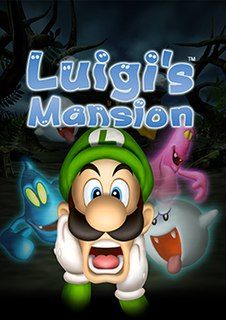 W
WLuigi's Mansion is an action-adventure video game developed and published by Nintendo for the GameCube. The game was a launch title for the GameCube and was the first game in the Mario franchise to be released for the console; it was released in Japan on September 14, 2001, in North America on November 18, 2001, in Europe on May 3, 2002, and in Australia on May 17, 2002. It is the second video game in which Luigi is the main character instead of Mario, after Mario Is Missing!. Players control him as he explores a haunted mansion, searches for Mario and deals with ghosts by capturing them through a vacuum cleaner supplied by Professor E. Gadd, a la Ghostbusters.
 W
WPauline is a fictional character from the Mario video game franchise, owned by Nintendo and created by Japanese video game designer Shigeru Miyamoto. The lead female character from the Mario vs. Donkey Kong series, she first appeared in Donkey Kong as the damsel in distress, being held captive by Donkey Kong at the top of a large construction site.
 W
WPrincess Peach Toadstool is a fictional character in Nintendo's Mario franchise, created by Shigeru Miyamoto and introduced in the 1985 original Super Mario Bros. installment. She is the princess regnant and ruler of the Mushroom Kingdom, where she resides in her castle along with Toads.
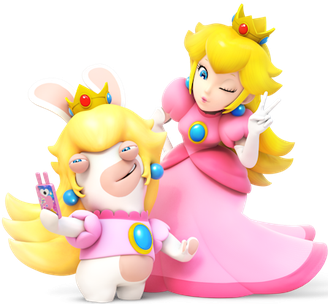 W
WRabbid Peach is a fictional character from the Rabbids video game franchise. First appearing in the crossover video game Mario + Rabbids Kingdom Battle, Rabbid Peach is depicted as a rabbit-like creature who parodies the Mario franchise character Princess Peach by dressing like her namesake. The character initially became known through game leaks of Mario + Rabbids Kingdom Battle in early 2017, and quickly attained a popular following. Following the commercial and critical success of Mario + Rabbids Kingdom Battle, Rabbid Peach has appeared in other crossover media.
 W
WRosalina, known as Rosetta in Japan (ロゼッタ), is a fictional character in the Mario series of video games. She debuts in Super Mario Galaxy, where she acts as a non-player character who resides in the Comet Observatory, the game's hub world. She is the adoptive mother of the Lumas, a fictional species of stars in the game, and also watcher of the cosmos. Rosalina has since appeared as a player character in subsequent Mario games, such as the Mario Kart, Mario Golf, Mario Party, and the Super Smash Bros. series.
 W
WToad is a fictional character who primarily appears in Nintendo's Mario franchise. A humanoid with a mushroom-like head, Toad was created by Japanese video game designer Shigeru Miyamoto, and is portrayed as a citizen of the Mushroom Kingdom and is one of Princess Peach's most loyal attendants, constantly working on her behalf. They are usually seen as a non-player character who provides assistance to Mario and his friends in most games, but there are times when Toad takes center stage and appears as a protagonist, as seen in Super Mario Bros. 2, Wario's Woods and Super Mario 3D World.
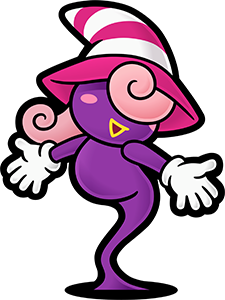 W
WVivian is a fictional character appearing in the 2004 role-playing video game Paper Mario: The Thousand-Year Door. She initially serves as an enemy to the player character Mario, later joining the player's party after he helps her. In the Japanese version and European language translations, she is a transgender woman, while the script in English releases was altered to remove any mention of her trans status. Vivian has been called one of the best LGBTQ characters in video games, but the way the Japanese version of the game depicts her and her gender identity has received some criticism.
 W
WWaluigi is a fictional character in the Mario franchise. He plays the role of Luigi's arch-rival and accompanies Wario in spin-offs from the main Mario series, often for the sake of causing mischief and problems. He was created by Camelot employee Fumihide Aoki and is voiced by Charles Martinet, who described Waluigi as someone who has a lot of self-pity and would "cheat to win."
 W
WWario is a fictional character and antagonist in Nintendo's Mario series, designed as an arch-rival to Mario. He first appeared in the 1992 Game Boy game Super Mario Land 2: 6 Golden Coins as the main antagonist and final boss. His name is a portmanteau of Mario's name and the Japanese word warui, meaning "bad". Wario was designed by Hiroji Kiyotake, and is voiced by Charles Martinet, who voices many other characters in the series, including Mario, Luigi, and Waluigi.
 W
WYoshi is a fictional dinosaur who appears in video games published by Nintendo. Yoshi debuted in Super Mario World (1990) on the Super Nintendo Entertainment System as Mario and Luigi's sidekick. Yoshi is the title character of the Yoshi series and a supporting character in Mario spin-off games such as Mario Party and Mario Kart, as well as many Mario sports games. It also appears as a playable character in crossover fighting game Super Smash Bros. series. Yoshi is a member of the same-named species, which is distinguished for its wide range of colors.